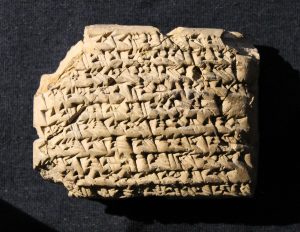
LB 1709 is a promissory note of silver dating to the reign of Darius and belongs to the reconstructed archive of a branch of the Ṣāhit-ginê family. The document records that Ina-Esagil-zēru-ibni owes silver to his nephew Nabû-ēreš and his unnamed nieces. While we do not know why Ina-Esagil-zēru-ibni was in debt, business transactions among members of the same family were not uncommon.
The cuneiform tablet LB 1709 is a legal document dating to the 25th year of the Achaemenid king Darius I. It belongs to a group of 24 tablets, which record the business activities of a branch of the Ṣāhit-ginê family (= Ṣāhit-ginê B). The Ṣahit-ginê family originates from Babylon, but at the time the tablet was written they had settled in Sippar already in the fourth generation.
Sippar (modern Tell Abu Habba) is situated upstream of Babylon and is the northernmost city of Babylonia. In addition to the archives of the Ebabbar Temple of the city god Šamaš, which contain 10,000s of tablets, about 18 private archives are known from Sippar so far. As is typical for the remnants of the archival material from 1st millennium Babylonia, a great deal of the tablets from Sippar has been unearthed in the course of illicit excavations. This is why the majority of the “archives” we are dealing with were reconstructed on the basis of the tablets’ distribution in modern museum collections (= museum archaeology) and prosopographical connections the documents’ contents reveal.
The archive of our branch of the Ṣāhit-ginê family belongs to the so-called “Maštuk group” comprising three illicitly excavated archives, including our archive, the archive of the Maštuk family (for a tablet belonging to this archive see the entry on LB 2043) and the archive of a certain Bēl-aplu-iddin. At the moment 83 tablets can be assigned to this group. They all exhibit the same pattern of museum distribution and show stronger prosopographical links to each other than to the temple archives and the remaining private archives from Sippar.
Almost all tablets of our Ṣāhit-ginê archive are currently housed by the Yale Babylonian Collection and the John F. Lewis Collection of the Free Library of Philadelphia. In addition, two tablets (including our tablet) are kept in the Böhl Collection in Leiden and another one at the Ashmolean Museum in Oxford. The archive covers a date range from the tenth year of Darius I to the first year of Xerxes, hence, about 28 years, but most of the tablets are concentrated around the years 24, 25 and 29 of Darius. Its termination in the first year of Xerxes marks the ‘end-of-archives’ phenomenon, which also applies to the other archives from Sippar as well as to most of the archives from other cities in North-Babylonia. This phenomenon is directly connected to the Babylonian revolts against Xerxes in his second year.
LB 1709, which dates to one of the peak years, is a legally binding promise of payment (= promissory note) for a certain amount of silver (the full amount is lost). As long as the debtor does not settle the debt, he has to pay 1 shekel of silver per mina as monthly interest. This corresponds to 20% interest per year which is the standard condition at that time. An additional clause stipulates that each year he shall also bring one sheep.
The contracting parties are all from the same family, namely the Ṣāhit-ginê family (here referred to with its alternate name Ṣāhit-sattukki). Nabû-ēreš and his sisters, children of Itti-Bēl-nuhšu, credit silver to Ina-Esagil-zēru-ibni, son of Kiribti-Marduk. As is evident from other documents, Itti-Bēl-nuhšu was also a son of Kiribti-Marduk and, hence, Ina-Esagil-zēru-ibni (also known as Saggillu) and Itti-Bēl-nuhšu were brothers (see the reconstructed family tree). Consequently, Nabû-ēreš and his sisters were the nephew and the nieces of the debtor Ina-Esagil-zēru-ibni.
The witness list confirms the impression that this was a family-internal transaction, since it only consists of members of the Ṣāhit-ginê family. The first witness Kiribti-Marduk is the father of the debtor Ina-Esagil-zēru-ibni and the grandfather of the creditors. Kiribti-Marduk’s other two sons Bēl-ittannu and Ina-qībi-Bēl are listed as witnesses thereafter.
The document dates to the 8th day of the 11th month of the 25th year of Darius which corresponds to the year 496 BCE in the Julian calendar. The place of writing is not preserved, but we have good reasons to assume that it was Sippar. The scribe of the document is Marduk-ēreš, son of Nabû-mukīn-apli who also wrote other legal documents for the Ṣāhit-ginês.
Legal transactions within the same family are not uncommon. According to another tablet from the Ṣāhit-ginê B archive, Itti-Bēl-nuhšu owes his brother Bēl-ittannu a residual amount of silver due to a house he purchased from him (FLP 1434). Up to now, one can only speculate about the background of our transaction, and why their uncle was indebted to Nabû-ēreš and his sisters. But it is well possible that we will find out more about it by looking at other tablets from this archive. To be continued.

Bibliography
- Jursa, M. 2005: Neo-Babylonian Legal and Administrative Documents: Typology, Contents and Archives (Guides to the Mesopotamian Textual Record 1), Münster.
- Waerzeggers, C. 2003/2004: “The Babylonian Revolts Against Xerxes and the ‘End of Archives’”, AfO 50, 150–173.
- Waerzeggers, C. 2014: Marduk-rēmanni: Local Networks and Imperial Politics in Achaemenid Babylonia (Orientalia Lovaniensia Analecta 233), Leuven.
Author: Melanie Groß
Published on 29 November 2018
